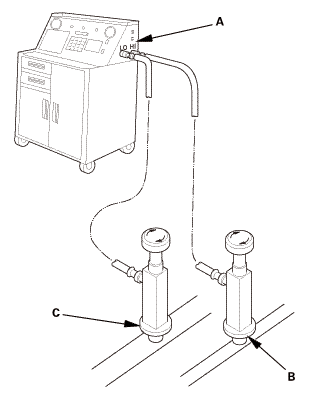Honda Civic Service Manual: A/C System Evacuation
 Procedure
Procedure

|
||
|
||
|
|
NOTE: |
|
|||
|
|
When an A/C System has been opened to the atmosphere, such as during installation or repair, it must be evacuated using an R-134a refrigerant recovery/recycling/charging station. If the system has been open for several days, the receiver/dryer should be replaced. Recover the refrigerant, if any, from the A/C system, and the system should be evacuated for several hours. |
|
NOTE: |
|
|||
|
|
A more efficient way to measure moisture removal is with a special tool called a compact electronic vacuum gauge, measuring vacuum levels in microns. |
|
Connect the tool according to the manufacturers instructions and allow the vacuum pump to run until the gauge reads 500 microns. |
|
Shut off and isolate the vacuum pump, then observe the gauge reading: |
|
|||
|
|||
|
| 1. | R-134a Refrigerant Recovery/Recycling/Charging Station - Connection |
|
|
|
| 2. | A/C Refrigerant - Recovery |
|
| 3. | A/C System Evacuation |
|
 A/C System Contamination Inspection (Except K24Z7)
A/C System Contamination Inspection (Except K24Z7)
Inspection
1.
A/C System - Contamination Inspection
1.
If A/C compressor failure is diagnosed, always use this inspection to
check the extent of conta ...
 A/C System Inspection
A/C System Inspection
Inspection
1.
A/C System Inspection
checkin!
NOTE: For A/C system noise, go to the A/C System Noise Check.
...
See also:
Honda Civic Owners Manual. Seat Belt Reminder
The seat belt system includes an indicator on
the instrument panel to remind the driver or a
front passenger or both to fasten their seat
belts.
If the ignition switch is turned to ON
*1 and
a seat belt is not fastened, a beeper will sound
and the indicator will blink. After a few
seco ...


